5 X Hong Kong Tiger Barbs – Puntigrus Tetrazona – Cyprinid Fish (5), Stunning Community Fish for Peaceful Aquariums, Perfect Schooling Companions for Any Tropical Tank, Easy Care for Beginners and Enthusiasts
£11.49 Original price was: £11.49.£9.68Current price is: £9.68.
Welcome these beautiful 5 X Hong Kong Tiger Barbs – Puntigrus Tetrazona into your peaceful aquarium. Known for their vibrant colors and playful nature, they thrive in groups, making them ideal community fish. Perfect for beginners seeking stunning tropical companions.
990 in stock
Species Introduction
The Hong Kong Tiger Barb, scientifically known as Puntigrus tetrazona, is a captivating species belonging to the Cyprinidae family. Originating from the freshwater rivers and streams of Southeast Asia, particularly in the regions of Malaysia and Borneo, these fish thrive in environments rich in aquatic vegetation and moderate water flow. Their vibrant colors and lively behavior make them a popular choice among aquarists looking to create a dynamic and visually appealing community tank. The Hong Kong Tiger Barb is characterized by its striking black stripes against a golden-yellow body, which not only enhances its aesthetic appeal but also serves as a means of communication among their schooling companions. As a species that exhibits natural schooling behavior, they are best kept in groups, which allows them to display their social dynamics and active swimming patterns, creating an engaging atmosphere in any aquarium.
Care Requirements Dashboard
✓ Care Level: Easy
Tank Size: 20 gallons minimum
Water Temperature: 74°F – 78°F (23°C – 26°C)
pH Level: 6.0 – 8.0
Water Hardness: 5 – 15 dGH
Natural Behavior & Temperament
The Hong Kong Tiger Barb is known for its energetic and playful nature. In their natural habitat, these fish are often found in schools, exhibiting a variety of social behaviors that are fascinating to observe. They are active swimmers, frequently darting around the tank, which not only keeps them healthy but also adds a lively ambiance to the aquarium. Their schooling behavior is essential for their well-being; solitary fish can become stressed and exhibit signs of aggression. When kept in groups of six or more, they display more natural behaviors, such as chasing and playing, which are vital for their mental stimulation. Additionally, they are generally peaceful fish, making them suitable companions for a variety of community tank setups. However, it is important to note that their playful nature can sometimes lead to fin nipping, especially if they are kept with slower-moving or long-finned species. Therefore, careful consideration should be given to tank mates to ensure a harmonious environment.
Tank Setup Guide
Creating an ideal environment for your Hong Kong Tiger Barbs is crucial for their health and happiness. A well-planned tank setup should include a minimum of 20 gallons of water, as this provides ample space for swimming and reduces territorial disputes. The substrate should be fine gravel or sand, which allows for easy burrowing and is gentle on their delicate bodies. Incorporating plenty of aquatic plants, such as Java Fern or Anubias, will not only enhance the aesthetic appeal of the aquarium but also provide hiding spots and territories for the fish. Additionally, driftwood and rocks can be used to create a natural environment that mimics their native habitat. These elements will help reduce stress and encourage natural behaviors. It is also essential to ensure adequate water circulation and filtration, as these fish thrive in well-oxygenated water. A gentle filter will suffice, as strong currents can be stressful for them. Lighting should be moderate to low, as bright lights can cause discomfort; using floating plants can help diffuse the light and create a more natural ambiance.
Water Quality Management
Maintaining optimal water quality is essential for the health of your Hong Kong Tiger Barbs. The ideal pH level for these fish ranges from 6.0 to 8.0, with a temperature between 74°F and 78°F (23°C – 26°C). Regular testing of water parameters is crucial to ensure that they remain within these ranges. A water hardness of 5 to 15 dGH is also recommended, as it mimics their natural habitat. Frequent partial water changes, approximately 25% weekly, will help maintain water quality by removing toxins and replenishing essential minerals. Additionally, using a high-quality water conditioner will ensure that any harmful chemicals, such as chlorine and chloramine, are neutralized. It is advisable to monitor ammonia and nitrite levels closely, as these should always be at 0 ppm to prevent stress and health issues. Regularly cleaning the substrate and performing routine maintenance on the filtration system will also contribute to a stable and healthy environment for your aquatic companions.
Feeding & Nutrition
Providing a balanced diet is vital for the health and vitality of your Hong Kong Tiger Barbs. These fish are omnivorous and thrive on a varied diet that includes high-quality flake food, pellets, and live or frozen foods such as brine shrimp, daphnia, and bloodworms. A well-rounded diet will enhance their coloration and overall health. It is recommended to feed them small amounts two to three times a day, ensuring that they consume all food within a few minutes to prevent water quality issues. Overfeeding can lead to obesity and poor water conditions, so moderation is key. Additionally, incorporating plant-based foods, such as spirulina flakes or blanched vegetables like zucchini and spinach, can provide essential nutrients and promote digestive health. Observing their feeding behavior can also provide insights into their well-being; active feeding is a good indicator of health, while a lack of interest in food may signal stress or illness.
Compatibility Guide
When selecting tank mates for your Hong Kong Tiger Barbs, it is essential to consider their social nature and active temperament. These fish are best kept in groups of six or more to reduce stress and promote natural behaviors. Suitable tank mates include other active community fish such as Tetras, Rasboras, and certain species of Gouramis. However, caution should be exercised when introducing slower-moving or long-finned fish, as the playful nature of Tiger Barbs can lead to fin nipping. Avoid keeping them with overly aggressive species or those that may outcompete them for food. Additionally, it is advisable to introduce new fish gradually to minimize territorial disputes and allow for proper acclimatization. Monitoring interactions among tank mates will help ensure a harmonious community tank, and any signs of aggression should be addressed promptly to maintain a peaceful environment.
Health & Wellness
The health and well-being of your Hong Kong Tiger Barbs depend on several factors, including water quality, diet, and tank conditions. Common health issues include fin rot, ich, and swim bladder disease. Regular monitoring of water parameters and maintaining a clean environment are crucial in preventing these issues. Signs of stress or illness may include lethargy, loss of appetite, and abnormal swimming patterns. If any of these symptoms are observed, it is essential to take immediate action, such as performing water changes or consulting with an aquatic veterinarian. Preventative measures, such as quarantining new arrivals and maintaining a stable environment, can significantly reduce the risk of disease. Additionally, providing a varied diet and ensuring that fish are not overcrowded can contribute to their overall health and longevity.
Breeding Information
Breeding Hong Kong Tiger Barbs can be a rewarding experience for aquarists. These fish are egg scatterers and typically breed in groups. To encourage breeding, it is advisable to set up a separate breeding tank with fine-leaved plants or spawning mops where the female can lay her eggs. The ideal conditions for breeding include slightly acidic water (pH around 6.5) and a temperature increase to around 80°F (27°C). After spawning, it is crucial to remove the adult fish, as they may consume the eggs. The eggs usually hatch within 24 to 36 hours, and the fry will become free-swimming after a few days. During this time, it is essential to provide infusoria or finely crushed flake food to ensure proper growth and development. As the fry grow, they can gradually be introduced to larger foods, and regular water changes will help maintain optimal conditions for their development.
Acclimation Process
Acclimating your Hong Kong Tiger Barbs to a new environment is a critical step in ensuring their health and reducing stress. When introducing new fish, it is essential to acclimate them slowly to the tank’s water conditions. The best method is the drip acclimation technique, which involves floating the sealed bag containing the fish in the tank for about 15 minutes to equalize the temperature. After that, gradually introduce small amounts of tank water into the bag every 10-15 minutes for approximately an hour. This gradual process allows the fish to adjust to the new water chemistry. Once acclimated, gently release the fish into the tank without adding the transport water. Monitoring their behavior closely during the first few hours will help ensure they settle in well and adapt to their new home.
Long-term Care
The long-term care of your Hong Kong Tiger Barbs involves regular monitoring of their environment and health. These fish can live for 5 to 7 years with proper care, so establishing a consistent routine is essential. Regular water changes, maintaining water quality, and providing a balanced diet will contribute to their longevity. Additionally, observing their behavior for any signs of stress or illness will allow for early intervention if needed. Keeping the tank clean and well-maintained, along with ensuring that they have ample space to swim and hide, will promote a healthy and thriving community. As they grow, it is important to monitor their size and adjust the tank environment accordingly, ensuring that they have enough room to thrive alongside their companions.
Natural Habitat Recreation
To recreate a natural habitat for your Hong Kong Tiger Barbs, consider incorporating elements that mimic their native environment. These fish thrive in densely planted areas with plenty of hiding spots, so using a combination of live plants, driftwood, and rocks will create a comfortable and stimulating environment. Aim to replicate the soft, slightly acidic waters found in their natural habitat by using natural substrates and incorporating leaf litter or peat. Additionally, providing shaded areas and open swimming spaces will cater to their active nature while allowing them to feel secure. Utilizing a variety of plant species can also enhance the aesthetic appeal of the aquarium while promoting a healthy ecosystem for your aquatic companions.
Seasonal Care Adjustments
Seasonal changes can impact the care of your Hong Kong Tiger Barbs, particularly regarding temperature and lighting. During the warmer months, it is essential to monitor the water temperature closely, as higher temperatures can lead to decreased oxygen levels and increased stress. Consider using a fan or aquarium chiller if necessary to maintain optimal conditions. In the cooler months, maintaining stable temperatures is crucial, as fluctuations can cause stress and health issues. Adjusting the lighting duration to mimic natural day and night cycles will also benefit their well-being. Providing a consistent environment throughout the year will help ensure that your fish remain healthy and active.
Expert Tips
For those looking to provide the best care for their Hong Kong Tiger Barbs, consider the following expert tips. First, always research potential tank mates before introducing new fish to ensure compatibility. Keeping a well-balanced community tank will reduce stress and promote healthy interactions. Additionally, maintaining a consistent feeding schedule and providing a varied diet will enhance their coloration and vitality. Regularly observing their behavior can help identify any potential issues early on. Lastly, engaging with fellow aquarists through forums or local clubs can provide valuable insights and support, enhancing your fish-keeping experience.
Troubleshooting
If you encounter issues with your Hong Kong Tiger Barbs, it is essential to address them promptly. Common problems include stress due to overcrowding, poor water quality, and incompatible tank mates. If you notice signs of aggression or fin nipping, consider increasing the number of fish in the school or rearranging the tank to reduce territorial disputes. In cases of illness, such as ich or fin rot, isolating affected fish and treating them in a quarantine tank may be necessary. Regular monitoring and prompt action can help prevent minor issues from escalating into serious health concerns.
Scientific Background
The Hong Kong Tiger Barb, Puntigrus tetrazona, is a member of the Cyprinidae family, which includes many popular freshwater species. This species has been extensively studied in terms of its behavior, breeding habits, and environmental needs. Conservation efforts are important as their natural habitats face threats from pollution and habitat destruction. Understanding their ecological role in their native environments can help aquarists appreciate the importance of providing a suitable home for these beautiful fish. Research into their social dynamics and interactions within schools continues to provide insights into their behavior and care requirements, making them a fascinating species for both novice and experienced aquarists.
Advanced Care Techniques
For experienced aquarists looking to enhance their care for Hong Kong Tiger Barbs, consider implementing advanced techniques such as breeding projects or specialized feeding regimens. Breeding these fish can provide valuable insights into their reproductive behaviors and fry care, while also contributing to the preservation of the species. Additionally, experimenting with different food types, such as live foods or high-quality pellets, can positively impact their growth and coloration. Engaging in regular water quality testing and adjustments will also ensure a stable environment, allowing for optimal health and vitality in your aquatic companions.
Water Quality Parameters
Optimal Range
24-27°C
6.5-7.5
0 ppm
Caution Zone
22-24°C or 27-29°C
6.0-6.5 or 7.5-8.0
0.25-0.5 ppm
Danger Zone
<22°C or >29°C
<6.0 or >8.0
>0.5 ppm
Monitoring Tip: Test water parameters weekly and perform regular water changes to maintain optimal conditions for your aquatic friends!
Frequently Asked Questions
Q: What tank size is required for Hong Kong Tiger Barbs?
Hong Kong Tiger Barbs thrive best in a tank that is at least 60 litres (15 gallons) in size. This provides ample swimming space and helps maintain stable water parameters. A larger tank is preferable as it allows for a more stable environment and reduces stress among these lively fish. Additionally, a well-planted aquarium with open swimming areas mimics their natural habitat, promoting their natural behaviour. Remember, these fish are social and should be kept in groups of at least five to prevent aggression and ensure they feel secure. A larger group will also enhance their stunning display of colours and patterns.
✓ Expert Tip
Consider adding driftwood and plants to your tank to create hiding spots, which can help reduce stress.
Q: What water parameters do Hong Kong Tiger Barbs require?
Hong Kong Tiger Barbs prefer slightly acidic to neutral water conditions, ideally within a pH range of 6.0 to 7.5. The water hardness should be moderately soft to hard, around 5-15 dGH. Maintaining a temperature range of 24°C to 27°C (75°F to 81°F) is crucial for their health and activity levels. Regular water changes of 10-15% weekly will help maintain optimal water quality, removing toxins and replenishing essential minerals. It’s also advisable to invest in a reliable water testing kit to regularly check these parameters.
✓ Expert Tip
Use a quality filter to help maintain stable water parameters and provide adequate water circulation.
Q: How often should I feed Hong Kong Tiger Barbs?
Feeding Hong Kong Tiger Barbs should occur 2-3 times per day, providing only what they can consume within 2-3 minutes. A varied diet is important for their health; include high-quality flake food, pellets, and occasional live or frozen foods such as brine shrimp or bloodworms. This not only ensures balanced nutrition but also enhances their colouration and vitality. Overfeeding can lead to poor water quality and health issues, so it’s essential to monitor their intake closely. Always remove any uneaten food promptly to maintain a clean tank.
✓ Expert Tip
Consider using a high-quality floating food to encourage natural foraging behaviour.
Q: What are the best tank mates for Hong Kong Tiger Barbs?
Hong Kong Tiger Barbs are generally peaceful but can exhibit nippy behaviour towards slower fish. Ideal tank mates include robust species such as tetras, rasboras, and danios. Avoid keeping them with long-finned fish like angelfish or bettas, as their fins may become targets for nipping. Additionally, ensure that all fish are of comparable size to prevent bullying. A well-planned community tank with plenty of hiding spots and swimming space will promote harmony and reduce stress among all inhabitants.
✓ Expert Tip
Consider keeping them in groups of 6 or more to disperse aggression and enhance their social behaviour.
Q: How do I properly acclimatise Hong Kong Tiger Barbs to my aquarium?
Acclimatisation is crucial for the health of your Hong Kong Tiger Barbs. Begin by floating the sealed bag in your aquarium for about 15-20 minutes to equalise the temperature. After this, gradually add small amounts of tank water into the bag every 5 minutes. Continue this process for about an hour, allowing the fish to adjust to the new water parameters. Finally, gently release the fish into the aquarium using a net, discarding the bag water to avoid introducing contaminants. This method reduces stress and helps them adapt better to their new environment.
✓ Expert Tip
Monitor their behaviour closely for the first few days to ensure they are adjusting well.
Q: What are the signs of healthy Hong Kong Tiger Barbs?
Healthy Hong Kong Tiger Barbs exhibit vibrant colours, active swimming behaviour, and a good appetite. Their fins should be held erect and they should be free from visible signs of disease, such as lesions, spots, or clamped fins. Observe their interactions with tank mates; they should be social and display normal schooling behaviour. If you notice lethargy, loss of colour, or refusal to eat, these can be indicators of stress or illness. Regular monitoring of their behaviour and health will help ensure they thrive in your aquarium.
✓ Expert Tip
Keep a close eye on water quality, as poor conditions can lead to stress and illness.
Q: How can I prevent common diseases in Hong Kong Tiger Barbs?
Preventing diseases in Hong Kong Tiger Barbs involves maintaining optimal water quality, stable temperatures, and a balanced diet. Regular water changes and monitoring parameters are essential. Quarantine new fish before introducing them to your main tank to prevent the spread of disease. Additionally, provide a stress-free environment with plenty of hiding spots and appropriate tank mates. If any fish display signs of illness, such as white spots, frayed fins, or unusual behaviour, separate them immediately to prevent contagion. Regularly check for signs of parasites or fungal infections and treat promptly if necessary.
✓ Expert Tip
Consider adding aquarium salt to the water occasionally to boost their immune system.
Q: What temperature should I maintain for Hong Kong Tiger Barbs?
The ideal temperature range for Hong Kong Tiger Barbs is between 24°C to 27°C (75°F to 81°F). Maintaining a stable temperature within this range is crucial for their health, activity levels, and overall well-being. Temperature fluctuations can lead to stress and make them more susceptible to diseases. It is advisable to use a reliable aquarium heater and thermometer to monitor the temperature accurately. Regular checks will ensure that any adjustments can be made promptly, keeping your aquatic friends happy and healthy.
✓ Expert Tip
Avoid placing the aquarium in direct sunlight or near heating vents to maintain consistent temperatures.
Q: How long do Hong Kong Tiger Barbs typically live in captivity?
In captivity, Hong Kong Tiger Barbs typically have a lifespan of 5 to 7 years, provided they are kept in optimal conditions. Factors such as water quality, diet, and tank mates play a significant role in their longevity. Regular maintenance, including water changes and proper filtration, will contribute to their overall health. Additionally, a varied and nutritious diet will ensure they remain vibrant and active throughout their lives. Caring for these fish with attention to their needs will enhance their lifespan significantly.
✓ Expert Tip
Keep a close eye on their behaviour and health to catch any potential issues early.
Q: What type of substrate is most suitable for Hong Kong Tiger Barbs?
Hong Kong Tiger Barbs do well with a variety of substrates, but a soft, sandy substrate is highly recommended. This not only mimics their natural habitat but also prevents injuries to their delicate fins. Additionally, a sandy substrate allows for easier cleaning and reduces the risk of harmful bacteria growth. If you prefer gravel, choose smooth, rounded grains to avoid any potential harm. Incorporating plants and decorations can help create a visually pleasing environment while providing hiding spots for the fish.
✓ Expert Tip
Ensure the substrate is clean and free from sharp edges before introducing it to the tank.
Q: What behavioural patterns should I expect from Hong Kong Tiger Barbs?
Hong Kong Tiger Barbs are known for their active and playful behaviour. They are social fish that thrive in groups and often display schooling behaviour, darting around the tank in unison. However, they can be territorial and may occasionally display nipping behaviour towards slower or long-finned fish. It is essential to provide ample swimming space and hiding spots to reduce stress and aggression. Observing their interactions can be quite entertaining, as they often engage in playful pursuits and explore their environment together.
✓ Expert Tip
Introduce them to the tank gradually to avoid territorial disputes.
Q: How can I recognise stress in Hong Kong Tiger Barbs?
Stress in Hong Kong Tiger Barbs can be indicated by several behavioural signs. Look for clamped fins, lethargy, and reduced appetite as primary indicators. They may also exhibit hiding behaviour or become aggressive towards tank mates. Changes in colouration, such as fading or darkening, can also signify stress. It is essential to assess their environment if you notice these signs, checking for water quality issues, compatibility with tank mates, and overall tank conditions. Addressing these factors promptly can help alleviate stress and promote a healthier aquarium.
✓ Expert Tip
Create a calm environment with plenty of hiding spots to help reduce stress levels.
Q: What natural habitat conditions should I replicate for Hong Kong Tiger Barbs?
In their natural habitat, Hong Kong Tiger Barbs inhabit rivers and streams with moderate to fast currents. To replicate these conditions in your aquarium, ensure proper filtration to create water movement. Incorporate fine gravel or sandy substrates along with plenty of plants to provide shelter and hiding spots. Maintaining a slightly acidic to neutral pH and a temperature range of 24°C to 27°C will mimic their natural environment closely. Regular water changes will also help maintain the quality, ensuring a healthy habitat for your aquatic companions.
✓ Expert Tip
Consider adding driftwood and rocks to create a more natural layout.

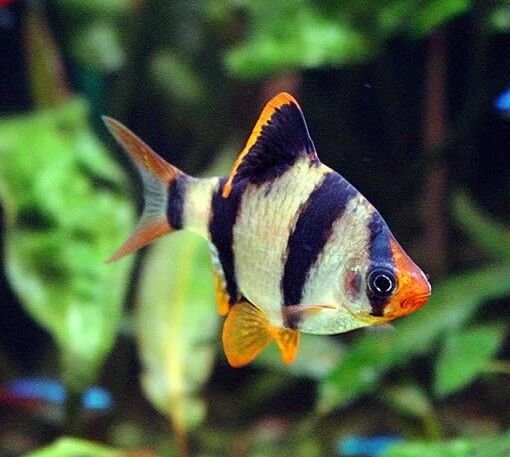
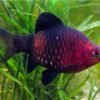
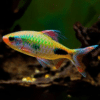
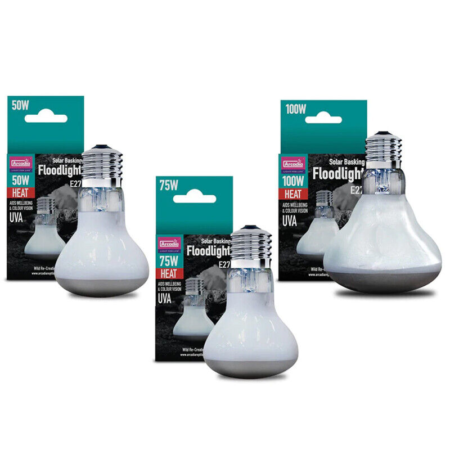
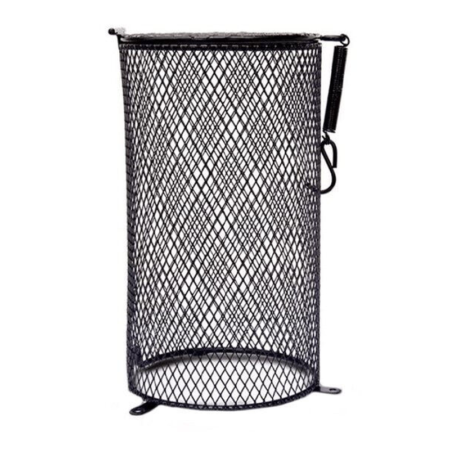
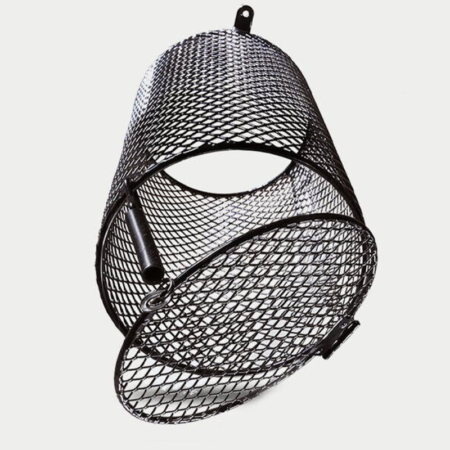
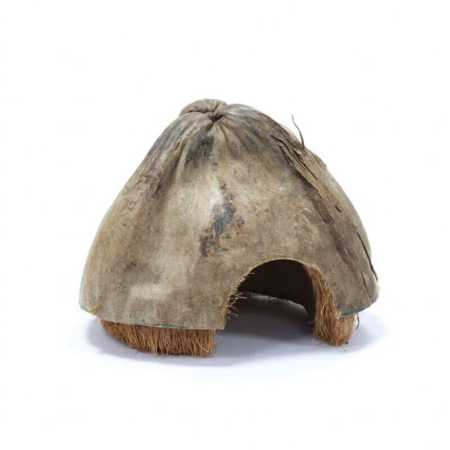





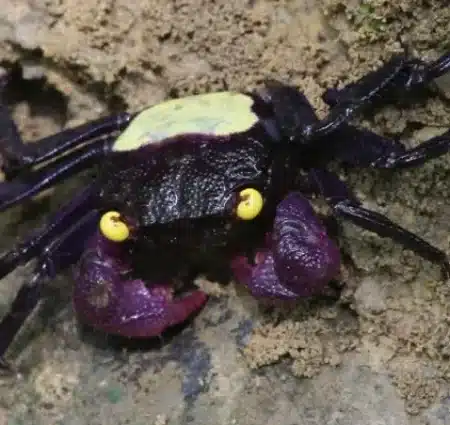
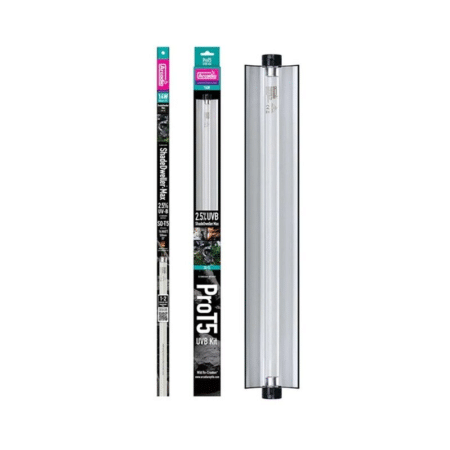
Emily Carter (verified owner) –
I recently added 5 Hong Kong Tiger Barbs to my 55-gallon community tank, and I couldn’t be happier! These little guys have brought so much life and color to my aquarium. After about two weeks, they’ve settled in beautifully, showcasing their vibrant stripes and energetic swimming patterns. I adore how they school together, darting around, which not only adds visual interest but also promotes a lively environment that benefits all my fish.
Compared to other barbs I’ve kept, like cherry barbs, the Hong Kong Tiger Barbs are much more active and engaging. Their playful antics keep me entertained for hours! I did notice a slight increase in my tank’s activity, so I make sure to do regular water changes to maintain a healthy environment.
These barbs are perfect for any hobbyist looking to add some dynamic schooling fish to their setup. Just ensure you have enough space for them to swim around freely, and keep them in groups of at least five for optimal happiness. I highly recommend these fish for anyone who prioritizes both aesthetics and fish welfare in their aquarium. You won’t regret it!
Emily Carter (verified owner) –
I recently added 5 Hong Kong Tiger Barbs to my 55-gallon tropical community tank, and I couldn’t be happier! These little guys are not only stunning with their striking stripes, but they are also incredibly active and social. Watching them dart around the tank brings so much joy! After about two weeks, they have settled in beautifully and are swimming in a tight school, which really enhances the dynamics of my aquarium.
What I love most is their peaceful nature, making them perfect companions for my other fish. I’ve had barbs before, but these are definitely my favorite due to their vibrant colors and engaging behavior. The shipping was quick, and they arrived healthy and lively, which is always a big plus for me as a caring fish parent. Just a note: they do appreciate space, so I recommend a tank of at least 30 gallons if you want to keep them happy.
I highly recommend these if you’re looking to add some life to your tropical fish tank. They thrive in a community setting and are ideal for both beginners and seasoned hobbyists like myself. Truly delightful fish for any aquarium enthusiast!